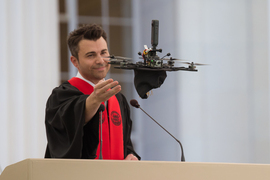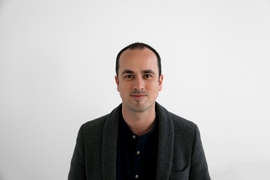When Lily Tsai led the MIT faculty onto Killian Court for the OneMIT Ceremony during Commencement last June, she was holding something that looked old but was, in fact, brand new: a ceremonial shepherd’s staff. It was a gift to the Institute from Tsai, chair of the MIT faculty from 2021 to 2023 and the Ford Professor of Political Science, that was designed by Professor Brandon Clifford of the Department of Architecture. The previous shepherd’s staff was a gift to the Institute in 1973 by then outgoing chair Professor Hartley Rogers Jr.
In a statement on the MIT Commencement website, Clifford and Tsai together describe the new staff and its symbolism:
“The staff symbolizes the chair’s role as leader of the faculty (the flock). This staff maintains the crook, though re-imagined as a temporal device for an institution that measures its work across decades and centuries. It is a terrestrial artifact, carved in concert with the two celestial bodies that govern the pace of the academic experience. The moon is represented by a brass dome at the base of the staff while the crook wraps around an imaginary sphere, the two figures defining Earth’s relative size and distance to the moon at the perigee of its orbit. The crook forms an angle of 23.5 degrees to serve as a solar ranging device. When the staff is aligned with the sun at noon on the equinox, this angle defines the limits of the sun’s path throughout the year, marking the solstice. The staff is carved from a black walnut tree that grew into the air, snatching carbon molecules from the atmosphere when aided by energy from the sun. It is hardened by the seasonal shifts of Earth’s tilt. If ignited, the staff will burn, revealing the energy it has preserved through time.”
The staff also includes a hidden compartment to hold 25 brass plates to be inscribed with the names and dates of service of the chairs of the faculty who will carry it, each of whom holds the position for two academic years. Like its predecessor, which has been transferred to the MIT Museum, the new staff is meant to be in use for 50 years.
An exciting design challenge
Tsai wanted to collaborate with other MIT community members on a new staff. Clifford was recommended to her because he had previously worked on designing ceremonial objects. “We have such magical people at MIT. I was incredibly lucky to have a colleague among the faculty to collaborate with,” Tsai says.
Clifford was excited to take on the challenge of creating something both ceremonial and functional; to find a balance between being recognizable as a traditional shepherd’s staff and distinguishing it as something special. The staff also needed to be of a comfortable size and weight for the chair of the faculty to carry during academic ceremonies.
Design began last April, with the two meeting several times to discuss the history and use of the staff at Commencement and to consider high-level concepts for the design. “We talked about how we wanted it to embody MIT values and the work that we do,” Tsai says. “To have something that was related to the ways in which we think, both scientifically and humanistically, but also the ways in which we try to root our work in the real world.”
Clifford says that he and Tsai share an interest in researching long-term thinking and wanted to make a statement about different scales of time. “The statement we were trying to make with the piece was that while humans think that 20 years is a significant number, an institution necessarily has to think on broader timelines,” he says.
“What's amazing about universities is that there aren't that many institutions that last decades and centuries,” Tsai adds. “I was keen to bring this into the design of the staff.”
These ideas led Clifford to look to celestial bodies for inspiration. The staff captures the current perigee of the moon’s elliptical orbit (the shortest distance between the two bodies). However, the moon is very slowly drifting away from Earth over time, at the rate of several centimeters per year. “If we imagine an archeologist coming upon this staff many years from now, the moon will never be closer than it is at the perigee today. It's a way of marking this moment in time while also thinking on these broader timescales,” says Clifford.
Designed for 50 years of use
The new staff was also designed to have a family resemblance to the previous one and to replicate its functional lifespan of 50 years. This influenced the choice of wood, hardware, and finishes. Black walnut, while not the type of wood that would be used for a utilitarian crook, was chosen because it makes for a nice artifact to be preserved and marks it as a ceremonial object, Clifford explains.
While beautiful to look at, the staff was deliberately designed to be humble, not flashy. The beauty comes from the material and the structure, rather than the ornamentation. The finish, for example, is matte, not glossy. Also, Clifford and Tsai decided to hide the 25 brass name plates from view, in a compartment behind a cover and accessible only with a special tool. “There's something about the spirit of that which I think is true to how we see ourselves at MIT, that it's enough to be part of a greater whole,” Tsai says.
Fabricated on campus
Once the design was settled in early May, Clifford and a team from the Department of Architecture consisting of Caroline Amstutz, Chris Dewart, Jen O'Brien, and Shah Paul began to fabricate the new staff. A plywood prototype was first created to test the functionality. Once that proved acceptable, three versions of the staff were carved in black walnut, using the department’s fabrication facilities. “When you're carving a natural material like walnut, you never really know what's on the inside,” Clifford explains. Two of the versions had cracks in them, but the third was perfect and so was chosen as the new staff.
The brass plates were also made on campus, in MIT’s Central Machine Shop. With the plates attached to the staff within the hidden compartment at the base of the staff’s hook, the center of mass is right above where a faculty chair would place their hand, making it comfortable to wield. “It's such a pleasure to hold,” she says. “Brandon wanted to make sure that it was proportioned and weighted so it would be comfortable for any future chair to hold regardless of height. That was a thoughtful part of the design.”
Overall, fabrication and finishing took about three weeks, ensuring the staff was ready for use by Tsai at the OneMIT Ceremony on June 1, 2023.
“The new shepherd’s staff is a wonderfully creative piece of design, and I am very grateful to Lily and Clifford for creating it,” says James Poterba, Mitsui Professor of Economics and chair of the Commencement Committee. “Since it is carried by the chair of the faculty at the head of the procession, it will be a focal point for the attention of both the graduates and their guests.”
Clifford says he thoroughly enjoyed working with Tsai on the staff. “It’s a rare thing to get to do,” he says. “Just having the conversations and talking about these broader concepts was really very refreshing and energizing.”
Tsai felt likewise about the experience and is very pleased with the result. “Brandon was great to work with, and it was wonderful to have this way of connecting intellectually and creatively with a colleague,” she says. “The new staff is just a really beautiful, meaningful representation of the MIT faculty.”













